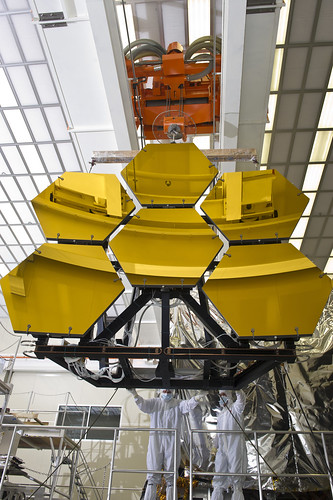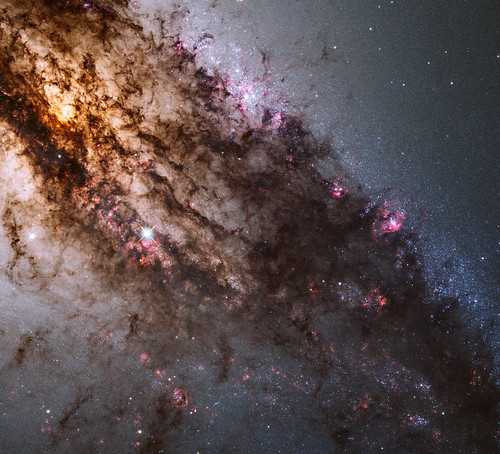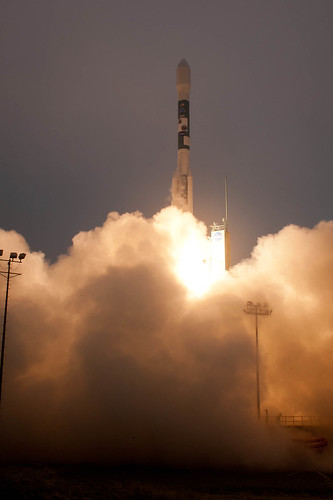Awesomeness Round-Up – 6/21/11
- By Faith Tucker
- June 21, 2011
- 3 Comments
As Maggie mentioned in her intriguing post last week, things have been quite busy around here recently. So here is a bit of a catch-up edition of your weekly Awesomeness Round-Up. Enjoy!
Historically, astronomy has always required a great deal of patience as astronomers spent long, cold nights at the telescope, but that was only the beginning. NASA’s Chandra satellite exercised even more extreme measures of patience while it stared at a tiny patch of sky for more than six weeks in order to observe the incredibly faint galaxies visible in the Chandra Deep Field South (pictured below). Chandra’s team announced last week that they had examined over 200 distant galaxies as they were approximately 800 to 950 million years after the Big Bang, finding that black holes were far more common in the early Universe than was ever previously suspected. These baby black holes will have continued to evolve into today’s supermassive black holes over the Universe’s 13 billion year lifetime.

Credit: X-ray: NASA/CXC/U.Hawaii/E.Treister et al; Infrared: NASA/STScI/UC Santa Cruz/
G.Illingworth et al; Optical: NASA/STScI/S.Beckwith et al
The Crab Nebula is the remnant from a powerful supernova in 1054 that lit up the night sky for two weeks and was even visible initially during the broad daylight. Recently NASA’s Fermi Gamma Ray Space Telescope and Italy’s AGILE telescope detected a series of ‘superflares’ from this well-known supernova remnant. These superflares release gamma rays that are thirty times more powerful than the nebula’s normal gamma ray output! Scientists here at Goddard think the mysterious outputs may be related to the pulsar residing in the heart of the Crab Nebula.
After lying dormant for more than 50 years, Chile’s Puyehue volcano erupted earlier this month sending an enormous ash cloud swirling over South America. The plume has since wrapped itself around much of the Southern Hemisphere, causing canceled flights as far away as South Africa and Australia. The GOES-2 satellite captured the action as the volcano spews material into the atmosphere.
Step by step, the James Webb Space Telescope is inching closer to completion. Last week the first 6 of 18 hexagonal mirrors completed a rigorous 10-week series of cryogenic testing at the Marshall Space Flight Center in Huntsville, Alabama. The mirrors were chilled to -379 degrees Farenheit and then returned to normal temperatures to ensure that they can withstand the dramatic temperature variations expected in space.
NASA’s Swift satellite scans the sky for gamma-ray bursts that result from the death of massive stars, and one particular burst that was observed in April of 2009 has recently set a new astrophysical record. After two years of laborious analysis it has been determined that GRB 090429B is the most distant GRB yet observed at 13.14 billion lightyears away. Such an extreme distance coupled with light’s finite speed of travels means that we are witnessing an event that took place a mere 520 million years after the Big Bang! This animation shows a gamma-ray burst resulting from a massive star’s collapse and detonation.
Credit: NASA/Swift/Cruz deWilde
The Indiana School for the Blind and Visually Impaired visited Goddard recently for a special program to encourage STEM (Science, Technology, Engineering, and Math) careers for the blind and visually impaired. These blind students and their sighted learning partners were able to explore the exciting research and engineering taking place at Goddard in a unique, hands-on fashion.
This gorgeous picture shows the eerie dark dust lanes and bright red star forming regions in the giant elliptical galaxy Centaraus A. A collision between Cen A and another galaxy caused shockwaves to reverberate through the dense Hydrogen clouds, triggering a “firestorm of star birth”.
NASA’s “Age of Aquarius” launched from Vandenburg Air Force Base in CA to study the saltiness of the oceans and global water cycles to improve climate forecasts. The instrument on board was built as a joint effort between Goddard and NASA’s Jet Propulsion Laboratory in Pasadena, CA.






Thank-you for the wonderful read during my coffee break, especially for the update on the James Webb Space Telescope.
How much “real” time elapsed in the satellite video of the Puyehue volcano plume?
Wicked cool post, as always, by the way!
Sid – Thanks! Looking at the timestamp on the video, it looks like it captured nearly 2 weeks of plume movement (6/4 – 6/16).